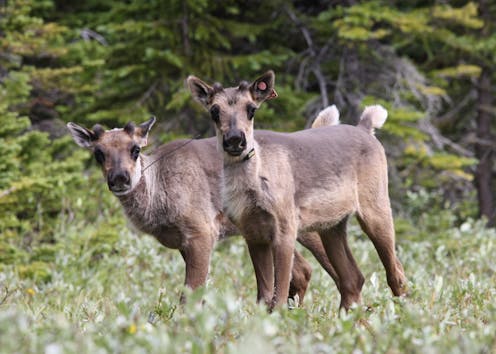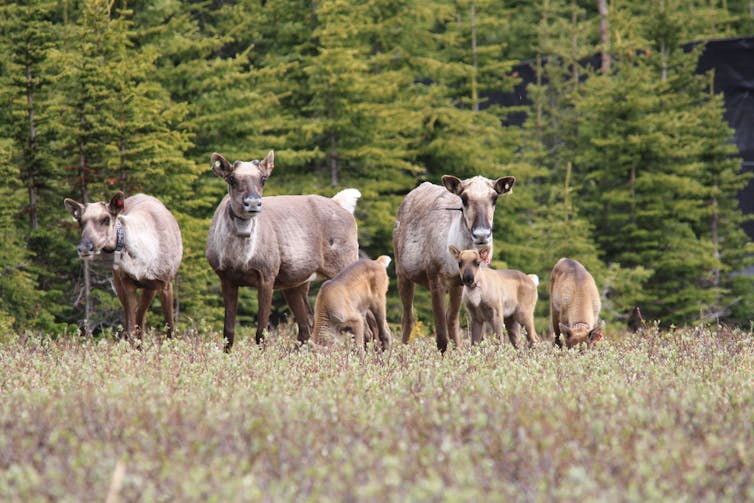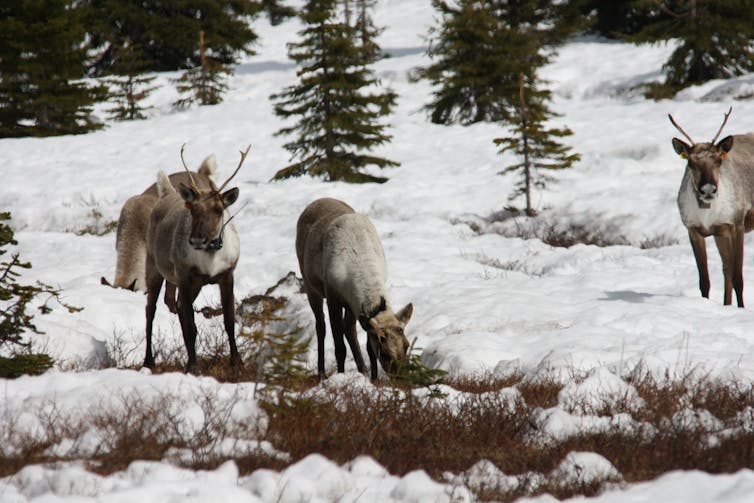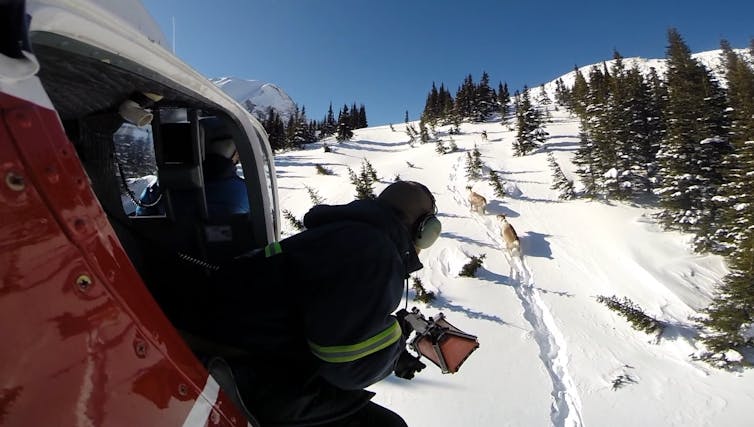
It’s been many years since community members from West Moberly First Nations last ate caribou meat from their traditional territory. Southern Mountain Caribou haven’t been hunted by this community in central British Columbia since it voluntarily decided to stop hunting them in the 1970s.
Caribou abundance is now a fraction of what it used to be. These endangered caribou have been rapidly dwindling across their range. In 2013, the Klinse-Za caribou found in the central Rocky Mountains of British Columbia had declined to 38 animals, and only 16 were counted from a helicopter during a province-led census.
This bleak news came after a neighbouring caribou herd, the Burnt Pine, was extirpated — made extinct in a particular region — the year before.
The forced cessation of caribou hunting due to the declining populations posed a key challenge for First Nations and Canada — signatories of Treaty 8. The treaty assured First Nations that “they would be as free to hunt and fish after the treaty as they would be if they never entered into it” — clearly a promise not kept. With an infringed treaty and an endangered species on the brink, time and patience were running out.
With caribou that were once described by West Moberly Elders as being as abundant as “bugs on the landscape” now rapidly disappearing, there were only two options: do nothing and watch extirpation happen within a decade, or do something to change the fate of these caribou.
An Indigenous-led effort to increase caribou abundance and cultural practices such as hunting is reshaping ideas about the best approach for caribou recovery and is successfully increasing the caribou population in B.C. every year. When I joined this project in 2020, there were 87 caribou. This number has now crossed 114 and is growing daily. In fact, we expect the birth of 20-30 calves this spring.
Extirpation was not an option
Caribou landscapes in Alberta and B.C. have changed a lot over the last century, altering predator-prey dynamics. Climate change and resource extraction have made some habitats more appealing for deer, moose and elk and introduced features such as roads or pipelines, allowing predators to move faster and farther. The caribou suffer unsustainable levels of predation due to more abundant and efficient predators including wolves, cougar, bears and wolverines.
West Moberly First Nations and Saulteau First Nations have been actively stewarding these landscapes for millennia. After colonization, they witnessed dramatic conversion of these lands, including the decline of caribou and many other impacts to ecosystems.
The First Nations were determined to avert the loss of caribou. After discussions with wildlife scientist Scott McNay of Wildlife Infometrics and others a decade ago, the two First Nations began an ambitious effort to recover caribou in their homelands.
The goal was to one day rekindle a culturally meaningful caribou hunt, which would be attained by increasing caribou abundance. The effort was collaborative from the outset, with the two First Nations working together with independent scientists, government and industry partners and conservation organizations to identify opportunities and initiate efforts.
The Klinse-Za recovery focused on emergency measures to reduce predation and a long term goal of recovering habitats to restore predator-prey dynamics from recent history.
Short-term measures to avoid extirpation
These First Nations began reducing caribou predation in 2013 by lowering the number of wolves in caribou habitat. While harvesting wolves is not something that is taken lightly, it was needed at this time to avert the loss of caribou. Trappers and hunters from the communities worked together to harvest wolves whose pelts were often sold or used to make goods for the community. British Columbia began reducing wolves as well in 2015.

In 2014, a maternal pen was added to further this conservation effort. Maternal pens are simple fenced enclosures in caribou habitats where adult female caribou are brought to birth and raise their calves safely. The goal of maternal pens is to protect calves during their first few vulnerable weeks of life when many are easily killed by predators.
Wolf reductions and maternal penning allowed the Klinse-Za caribou to triple in less than a decade. This unprecedented increase — to 114 animals in 2022 from 38 animals in 2013 — signals the success of the actions enacted by West Moberly First Nations, Saulteau First Nations and Wildlife Infometrics.
Longer term visions
With the threat of extirpation reduced, West Moberly First Nations, Saulteau First Nations and the governments of British Columbia and Canada came together to plan long-term goals including habitat protection and restoration.
In February 2020, a landmark partnership agreement was signed between the four parties that secured 7,900 square kilometres for caribou. The agreement covers the Klinse-Za caribou as well and five adjacent subpopulations, and will provide the endangered caribou with essential habitat security.

This was one of the only examples where emergency responses such as wolf reductions and maternal pens have been followed up with expansive habitat protections in such short order.
Unfortunately, the norm is currently a lack of habitat protection while caribou habitat continues to get worse. However, this Indigenous-led conservation effort in central British Columbia is poised to change that by working together with different groups to restore the habitats needed to sustain the vulnerable caribou.
Weaving knowledge and working together
As I worked with West Moberly First Nations, Saulteau First Nations, Wildlife Infometrics and university partners, I found that Indigenous stewardship and the collaboration of all these different groups was the key to this successful recovery.
Indigenous leaders exercised their treaty rights for rapid and effective recovery measures, while helping people rethink what endangered species conservation means. The many groups helped weave western and Indigenous knowledge and skills to produce a robust program for conserving caribou.

Realizing habitat restoration at the scale of a caribou sub-population, which spans thousands of square kilometres, can take more than 25 years. It involves removing roads and other linear features such as seismic lines and reducing or eliminating industrial activity in some areas. Once the restoration of these linear features is done, the trees throughout the landscape need to grow.
The next step of the collaborative caribou recovery focuses on healing the landscape through these measures so it can support caribou without interim measures such as wolf reductions or maternal penning. Because of the strong partnerships nurtured to date and the habitat protections secured, the caribou habitats in central British Columbia are poised to be leading examples of what restored landscapes for caribou look like.
The project is a testament to what’s possible when people come together to achieve a common goal by proving that grassroots initiatives can do the impossible.
Clayton Lamb has received funding from the governments of BC and Canada, Liber Ero Fellowship, and Canadian Mountain Network, to conduct the research described here. Clayton Lamb has received funding from Industry partners (Teck Coal) and environmental organizations (Yellowstone to Yukon, Habitat Conservation Trust Foundation) to conduct wildlife coexistence work in the BC Rockies.
This article was originally published on The Conversation. Read the original article.







